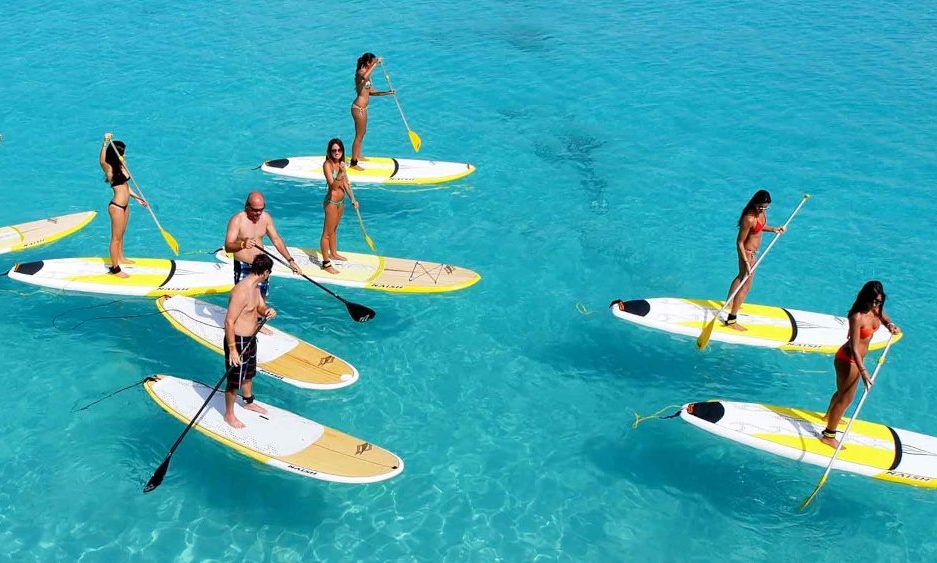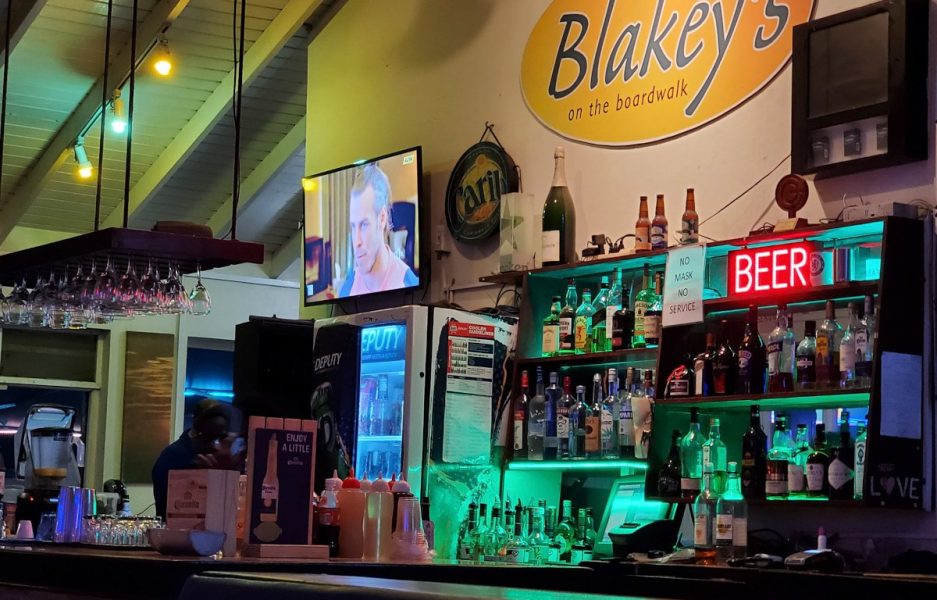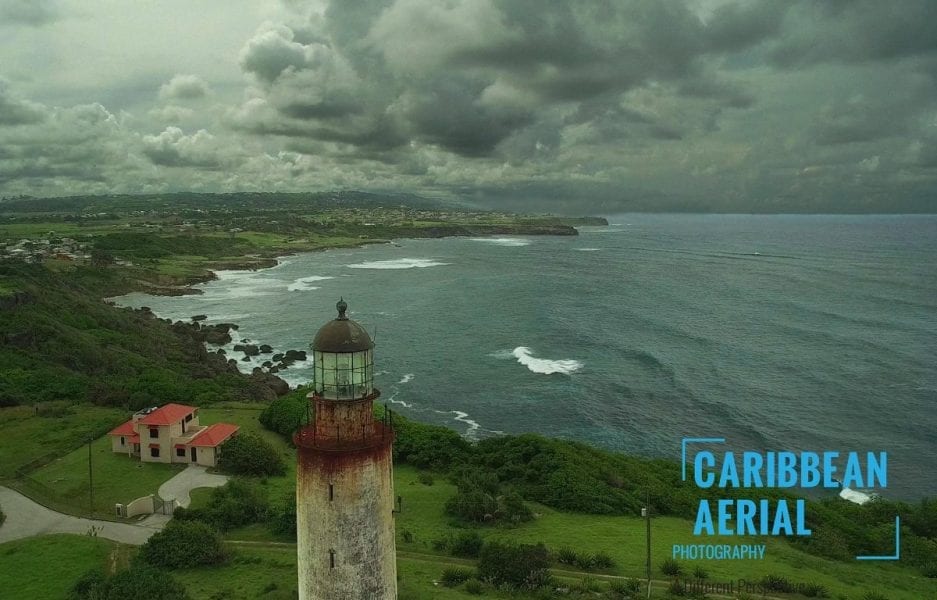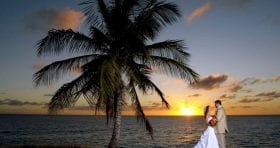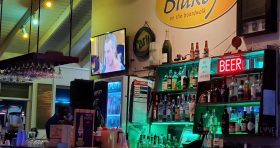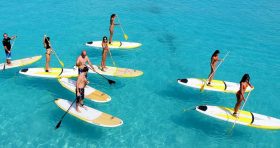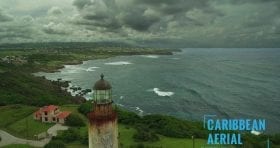About Barbados
Do you want to learn about the island country Barbados? You can find all the insider informational travel guides on everything you need here.
Don’t let the fact that Barbados is a small island fool you. What the island lacks in size, it makes up for in charm. The island ranks highly in the global population indexes. Notably, the literacy rate is nearly 100% (one of the world’s highest).
Also, Barbados was named the most-ranking destination in the Caribbean and the world’s 58th most innovative nation, according to The Travel and Tourism Competitiveness Index 2017 Report by The World Economic Forum.
Barbados – the jewel of the Caribbean
Fun Facts – Barbados has long been known as The Land Of The Flying Fish, with the national dish being cou-cou and flying fish.
She was also known as The Birthplace of Rum. With over 300 years of experience, Mount Gay Distillery is the oldest rum distillery globally. Mount Gay Rum is infused with quality, sophistication, and classic style that can only be achieved through a long history of excellence and tradition.
The island’s warm waters, rich in minuscule plant and animal organisms, provide an excellent food source for the flying fish, providing its people with a high-protein dietary staple for centuries.
To see a teeming shoal of these silver and blue creatures leap from the seas and take to the air is simply a breathtaking experience. Cruise line passengers and local fishermen have reported seeing schools as large as 1,000 fish-strong leap into the air and glide for 70 feet.
It is further estimated that they can travel at speeds approaching 55 kilometers per hour and stay airborne for over 10 seconds. Their two pectoral fins and two ventral fins fan out to act as wings, while the flying fish’s tail fin is what propels them in flight. Leaping mainly to avoid sizeable predatory fish will ultimately return to the water once their fins dry.
Barbados is the most eastern Caribbean island in the chain, otherwise known as the Lesser Antilles in the West Indies. It is above South America, northeast Venezuela, north of Guyana, and east of St. Vincent and the Grenadines.
The Atlantic Ocean sits to the east of the island and the Caribbean Sea to the west. The capital city is Bridgetown, located in the parish of St Michael. The limestone rock created the island, and the land area of the isle measures 166.4 square miles (431 km2). It is 21 miles (34 kilometers) in length and 14 miles (23 kilometers). Barbados is endowed with healthy and vibrantly colored coral reefs. Scuba divers can expect abundant sea life and excellent snorkeling conditions.
Blessed with various hard and soft coral formations, the surrounding waters host many sea creatures and colorful fish life. The terrain is relatively flat in comparison to other Caribbean islands.
However, there is a gentle rise to a central highland region – Mount Hillaby in St Andrew’s parish- the highest point, measuring approximately 1,115 feet above sea level.
History – 1400’s Portuguese Visitors
In the 1400s, the Portuguese reached Barbados while sailing through to Brazil. They had no desire to fight with the fierce Caribs, so they did not attempt to colonize the island. However, thanks to one of their sailors, Pedro, a Campus, the island first received the name ‘Barbados.’
Legend says that when Campus saw the native bearded fig trees with a distinctive beard-like feature, he dubbed the island ‘Los Barbados’; Portuguese for ‘The bearded ones.’
Want to know more? Learn more about the weather, hurricanes, tropical storms, and depressions that affect the island.
February 17th, 1627 – The First Settlements
John Powell returned to Barbados and informed his employer, Sir William Courteen, that he had discovered an uninhabited island and claimed it in King James’s name.
Immediately, Courteen sent Powell back to the island to occupy Barbados and establish a settlement. However, Powell never made it; en route, he captured a Spanish ship and needed to return it to England.
Before long, Courteen financed a second voyage with a band of 80 settlers. This time, Henry Powell, John’s brother, captained this ship, the “William and John.” Despite another skirmish on the way, where Powell captured ten enslaved people, the expedition sailed and landed in Barbados on February 17th, 1627.
Once on land, Powell unfurled the royal standard to show that Barbados was in English possession and called the area of the first settlement’ Jamestown.’
Parliament
Established on June 26th, 1639, the Parliament is the third oldest Parliament in the Americas (behind The Virginia House of Burgesses and Bermuda House of Assembly). It is among the oldest in the Commonwealth of Nations.
After being recognized as a British colony for over 300 years, Barbados was granted its complete independence from Britain on November 30th, 1966, led by the Right Excellent Errol Walton Barrow, who became the first Prime Minister.
In 2020, the Parliament voted to transition from a constitutional monarchy to a parliamentary republic (link to new TB republic article) consisting of a Prime Minister / and a ceremonial President as Head of State.
“The time has come to leave our colonial past behind fully,” Dame Sandra Mason said during the annual 2020 Throne Speech, delivered on behalf of Prime Minister Mia Amor Mottley.
“Barbadians want a Barbadian Head of State.”
The following year, on October 12th, 2021, Dame Sandra Mason was nominated to become the first President of Barbados and then unanimously elected by the two houses of Parliament in a special sitting of the lower and upper houses. Please read about it at the GIS (Government Information Service) for more information.
Although her role is primarily ceremonial, and Barbados will remain a member of the Commonwealth of Nations, Sandra Mason was sworn in as President of Barbados and assumed office coinciding with the official national Independence Day (November 30th).
In 2023, this day marked the 57th year of independence and the day the island became the world’s newest republic.
The British Queen was officially removed as the Head of State in a Presidential Inauguration Ceremony hosted at Heroes Square in Bridgetown.
Prince Charles was a guest of honor at the event, which included one final salute before the British Monarch’s Royal Standard flag was ceremoniously taken down and replaced to mark the official change of constitutional status.
Previously named an ‘Ambassador’ for Barbados, Barbadian pop star Rihanna was also in attendance and was our prestigiously designated Prime Minister, a new national hero.
Mason concluded following the late-night ceremony: “Vessel Republic Barbados has set sail on her maiden voyage. May she weather all storms, land our country and citizens safe on the horizon, and shores ahead of us.”
- The Parliament is divided into the House of Assembly and The Senate.
- The former, known as ‘the lower house,’ comprises elected members while the Senate or upper chamber members are selected.
- Thirty members sit in the House of Assembly and are elected in a ‘first past the post voting system.
- The House of Assembly of Barbados is the lower house of the bicameral Parliament of Barbados.
- It has 30 Members of Parliament (MPs), who are directly elected in single-member constituencies using the simple-majority (or first-past-the-post) system for five years.
- The House of Assembly sits roughly 40–45 days a year and is presided over by a Speaker.
- The House of Assembly chamber is in the east wing of The Public Buildings on Broad Street in Bridgetown.
- Prime Minister and Minister of Finance, Economic Affairs, and Investment – Mia Amor Mottley
- Speaker of the House of Assembly – His Honour Arthur E. Holder, LL.B.
- There are 21 members in the Senate: 12 appointed by the Prime Minister, seven by the Governor-General, and two by the opposition’s leader.
- The Barbados Labour Party – BLP (30)
- The Democratic Labour Party (DLP)
- People’s Party for Democracy and Development – PDP
Historic Bridgetown and Barbados Garrison
Historic Bridgetown and Barbados’ Garrison area are now on the United Nations Educational Scientific and Cultural Organization’s (UNESCO) World Heritage List. Now that Bridgetown and its Garrison have been listed on the UNESCO World Heritage List, Barbadians can feel even more proud of their heritage and culture.
Currency
The currency of Barbados is the Barbadian dollar (BDS). Robust, stable, and secure, the dollar has been pegged to the US dollar at 1.98 to 1 since 1975.
Climate and the Weather
Located just north of the equator, Barbados has a moderate tropical climate. Temperatures typically range from 80-86 degrees Fahrenheit (27-30 degrees Celsius) to 70 – 76% humidity for most of the year.
December to May is considered the dry season and the ‘winter’ period for most northern hemispheres.
The wet season begins in June and runs until November, the ‘summer months for the island. This season also brings the Caribbean hurricane season, although Barbados continually tends to be spared any significant storm’s direct hit.
The People – Best Asset of Barbados!
According to the 2010 Population and Housing Census, the Population of Barbados is approximately 280,000 people.
The population is a diverse melting pot of individuals, most of whom are of African descent. The people are of mixed race, Caucasian or European ancestry, East Indian, Oriental, and Middle Eastern.
Bajans are renowned for being very friendly. With tourism being a significant contributor to the economy, it’s evident that the people are this tiny island’s best-kept asset.
For a more in-depth look at its people, learn about the Population and Meet a Bajan.
National Heroes
There are ten (10) official National Heroes of Barbados.
These ten individuals, nine men and one woman, came from different eras and various walks of life.
However, they had a few things in common. They were all champions of a cause, influenced positive social change and sustainable development, and supported them.
It is only proper then to pay tribute to these fine individuals contributing to our history.
Meet Rihanna
The pop princess has been riding high on a sea of success since record producer Evan Rogers discovered her at just 16 in Barbados.
Fortunately, Rihanna received the break she had been looking for – a friend knew the wife of record producer Evan Rogers. Through this connection, she was allowed to audition for him.
Evan Rogers immediately saw that she had talent, and in her school holidays, he flew Rihanna to New York to record her first demo.
At 17, Rihanna released her first album in 2005, ‘Music of the Sun,’ which reflected her Barbadian ‘dancehall’ roots.
Her album reached the top ten of the Billboard 200 chart and featured her hit song, ‘Pon de Replay,’ but it didn’t stop there.
Rihanna went from strength to strength, and her second album, ‘A Girl Like Me,’ became one of the top five on the Billboard Albums chart.
Growing up in St. Michael’s parish on her little island rock, Barbados, she moved to the USA and was snapped up by hip-hop record label Def Jam Recordings.
In 2007, Rihanna released her third album, ‘Good Girl Gone Bad,’ for which she won a Grammy Award for the featured hit’ Umbrella,’ which she sang alongside Jay-Z, the owner of her record label, ‘Def Jam Recordings.’
Rihanna catapulted onto the worldwide stage, her image and persona have risen into the stratosphere, and Rihanna, the Bajan pop star, was born.
As of August 2011, she has sold over 20 million albums and 60 million singles, making her one of the best-selling artists.
Rihanna now rocks the world with her panache, tenacity, sexuality, and power; however, it never used to be this way for Rhianna.
Underneath her signature red hot hair, Rihanna, born Robyn Rihanna Fenty, is a Bajan girl who grew up in Bridgetown in a three-bedroom bungalow and helped her father sell clothes on a stall.
Her mother is a retired Afro-Guyanese accountant, and her father was an Irish warehouse supervisor who suffered from heart-breaking crack cocaine, marijuana, and alcohol addiction.
Rihanna’s parents separated when she was just 14. However, she did not let this upset stop her from following her musical dream, and while at Combermere school, Rhianna started a band with two friends.
- Rihanna Soars to the Top of the International Charts
- Superstar Rihanna is at home in Barbados for the annual Crop Over Festival
- Diamonds World Tour and Rihanna Comes to Barbados
British English is the official language of the island
In more formal settings, British English is both spoken and written. However, Barbadians speak a unique Bajan dialect in most casual settings – a version of broken English, or pidgin (a simplified version of) English, mixed with very distinctive ‘Bajanisms.’
This local language can be tricky to follow, especially for visitors to the island. However, you’ll soon pick it up and speak like an honorary Bajan in no time!
How to Talk Bajan? Learn more about our Language and Dialect.
Religion remains at the center of culture in Barbados. Anglican is the national religion of Barbados. However, various denominations of Christianity and non-Christian religions are practiced in Barbados.
Airport
Today, Barbados proudly boasts its only airport, Grantley Adams International Airport (GAIA), a showpiece and the gateway for the two million commercial passengers arriving and departing each year. The 11,000 ft asphalt runway is one of the longest airport runways in the eastern Caribbean.
Sugarcane Industry
Sugar production, the backbone of the economy for decades past, is now mainly in decline as world market prices plummet and manufacturing costs continue their upward spiral.
Although the production cost has exceeded the global selling price, Barbados has maintained the industry for its foreign exchange value.
Over the last four decades, the island found help in several agreements and arrangements with Britain and the European Union (EU), which accepted Barbados’ sugar at preferential prices.
However, the economic challenges led to the number of factories shrinking from 10 to 2. Today, only Andrews Sugar Plantation and Factory in St. Joseph and Portvale in St. James produce sugar.
The industry has also moved from labor-intensive to complete mechanization to improve efficiency and maintain production costs.
There’s something in the water.
The water in Barbados is very safe to drink as it is filtered naturally through coral limestone rock. Over 85% comprises coral limestone, meaning the water is of a very high quality.
Swimming is safe on both the west and south coasts. However, we recommend you exercise caution swimming on the southeast, east, and north shores due to the Atlantic Ocean’s currents’ unpredictable nature.
Water sports are top-rated, with waves on the south coast that are excellent for wind and kite surfing activities. Bathsheba on the East Coast is famous for the Soup Bowl – a hot spot for experienced surfers.
Accommodation
There are many options when choosing your holiday accommodation.
There is something for everyone – from luxurious hotels and condominiums to self-catering apartments, guesthouses, and beach cottages. See our Accommodation guide and local hotels for a comprehensive tour of the island’s accommodations.
Regarding Sightseeing, there are tourist attractions galore.
Barbados is much smaller than Jamaica, and driving around the island entirely in a few hours is possible.
Would you like to tour the island on an organized tour? Or grab a map, hire a car, and get around Barbados.
You can visit tropical gardens dotted all over the island or spend a day at the beach, each with its unique character and atmosphere.
Did you know?
Barbados has one of the oldest Westminster-style parliaments in the Western Hemisphere. Our Parliament is the 3rd oldest in the Commonwealth, surpassed only by those in Britain and Bermuda. Walk through the capital city and get pictures of parliament buildings.
If art’s your thing, there is also a thriving art community with lots of local work for sale at various galleries nationwide.
Don’t know where to start? See our tourist attractions guide to help you decide where to visit first.
George Washington Visits Barbados
It’s a little-known fact, but a very important part of history, that George Washington (the first President of the United States of America) visited Barbados during the 18th century.
A young 19-year-old George Washington arrived in Barbados on 2 November 1751 with his ailing older half-brother, Lawrence Washington, who had fallen victim to tuberculosis.
It was hoped the island’s tropical climate would improve his health and recovery, so the brothers rented a historic plantation house on Garrison ridge (on the outskirts of Bridgetown), known as Bush Hill House, where they stayed for six weeks.
Crop Over Festival
The Caribbean has four official seasons – Carnival, Cricket, Crop Over, and Christmas.
Crop Over Festival is the most significant cultural Festival and signifies the end of the once-dominant sugarcane crop harvest. The party carnival involves various entertainment and celebrations that bring thousands of tourists to the island each year.
Crop Over season is held throughout July and ends in a big Grand Kadooment Day finale parade on the first Monday of August.
This massive street parade brings local and international revelers from the United States to ‘jump up’ in extravagant costumes from Warrens in St. Michael to the Spring Garden Highway, where the party continues to the early morning hours. And the best part is that anyone can join in the festivities, so it’s a definite ‘must-do.’
In the lead-up to the parade, the Festival features numerous calypso and soca music competitions, among other cultural activities. For many expats, July and August are the most popular to return home, coinciding with the Crop Over fun and frivolity.
I love the nightlife!
You will miss out if you don’t take the time to spend the nightlife with family and friends.
Some of the world’s best restaurants are in Barbados, so dine at a local restaurant.
We can read about our restaurants in our Places to Eat and Dining Guide. You will access restaurant contact details, essential for making your dinner reservation.
After dinner, you may wish to party the night away from the many options available for nightlife. One of the most popular nightspots is St. Lawrence Gap on the south coast, in the parish of Christ Church, where numerous bars (karaoke included) are available to check out. For more information, learn about the St. Lawrence Gap.
Maybe you’d like to wear your dancing shoes and venture to one of the island’s top nightclubs – Harbour Lights, conveniently located on the outskirts of Bridgetown. Combining dinner with a show is another popular option at Harbour Lights.
For a more rustic night out, you could go to a local fish fry and sample the day’s catch while enjoying the local rum. The infamous Friday night Oistins Fish Fry is one such place and a popular venue for locals and tourists. You can read about the quaint little fishing village of Oistins on the island’s south coast for more information.
Need more nightlife options?
Learn about the entertainment districts and nightlife options, such as the Barbados Gold Coast (west coast) and Holetown.
And the best part is…that there is something for everyone. The island caters to all styles, tastes, and budgets, so your holiday can be as busy, relaxing, high-end, or low-end as you please. Book your ticket today – the island awaits you!
Photos
See photos of Bridgetown, take a tour around, and visit Rihanna Drive and the Barbados Parliament Buildings within our Adobe Portfolio.


